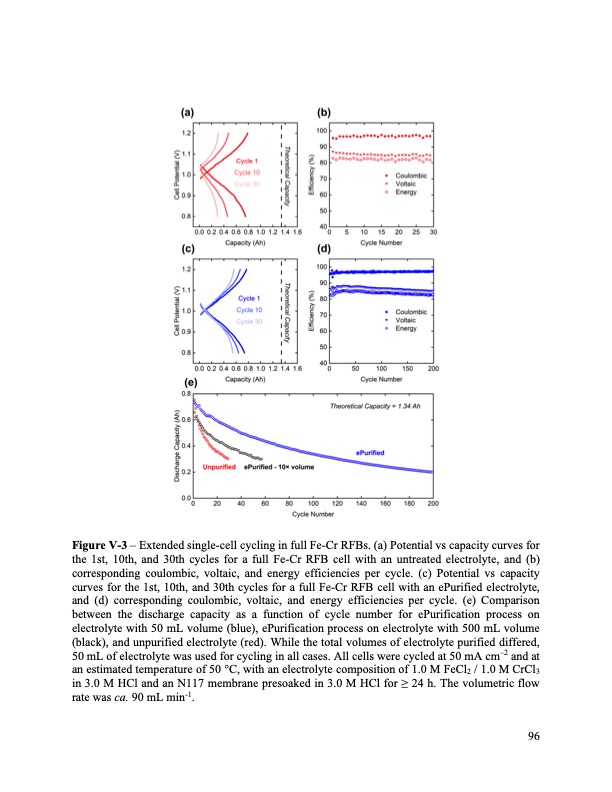
PDF Publication Title:
Text from PDF Page: 096
Figure V-3 – Extended single-cell cycling in full Fe-Cr RFBs. (a) Potential vs capacity curves for the 1st, 10th, and 30th cycles for a full Fe-Cr RFB cell with an untreated electrolyte, and (b) corresponding coulombic, voltaic, and energy efficiencies per cycle. (c) Potential vs capacity curves for the 1st, 10th, and 30th cycles for a full Fe-Cr RFB cell with an ePurified electrolyte, and (d) corresponding coulombic, voltaic, and energy efficiencies per cycle. (e) Comparison between the discharge capacity as a function of cycle number for ePurification process on electrolyte with 50 mL volume (blue), ePurification process on electrolyte with 500 mL volume (black), and unpurified electrolyte (red). While the total volumes of electrolyte purified differed, 50 mL of electrolyte was used for cycling in all cases. All cells were cycled at 50 mA cm–2 and at an estimated temperature of 50 °C, with an electrolyte composition of 1.0 M FeCl2 / 1.0 M CrCl3 in 3.0 M HCl and an N117 membrane presoaked in 3.0 M HCl for ≥ 24 h. The volumetric flow rate was ca. 90 mL min-1. 96PDF Image | Bringing Redox Flow Batteries to the Grid

PDF Search Title:
Bringing Redox Flow Batteries to the GridOriginal File Name Searched:
Rodby-krodby-phd-chemE-2022-thesis.pdfDIY PDF Search: Google It | Yahoo | Bing
Salgenx Redox Flow Battery Technology: Salt water flow battery technology with low cost and great energy density that can be used for power storage and thermal storage. Let us de-risk your production using our license. Our aqueous flow battery is less cost than Tesla Megapack and available faster. Redox flow battery. No membrane needed like with Vanadium, or Bromine. Salgenx flow battery
| CONTACT TEL: 608-238-6001 Email: greg@salgenx.com | RSS | AMP |